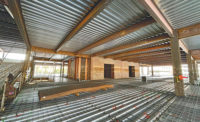The American Institute of Steel Construction’s virtual steel conference—which replaced AISC’s annual gathering canceled due to the COVID-19 pandemic—offered dozens of no-cost online professional development hours to its 9,146 registrants. But due to the limitations of webinar-like events, AISC had to cancel some sessions and activities originally planned for April 22-24 in Atlanta. Among those was the formal roll-out of an unprecedented six-year program, dubbed Need for Speed, designed to enable building teams to slash in half, by 2025, the time it takes to produce a steel-framed building or bridge.
“We do think our plan is ambitious, but in a good way,” says Charlie Carter, AISC’s president.
The Need for Speed program represents a major departure for AISC, which has largely been focused on boosting structural steel’s market share by lowering the cost of steel. “This is different,” says Lawrence F. Kruth, AISC’s vice president of engineering and research.
“This is how we are going to save money for the owner,” he adds.
Seeds for the initiative, which AISC is funding this year with $750,000 and part of its annual $1 million for research, were planted last year by Jack Klimp, AISC’s current chairman of the board and general manager of Cianbro Fabrication & Coating Corp. “Jack seized on the idea of delivering added value” to the entire building team, from the owner on down, says Carter. That translated to increasing speed to market, which generates revenue faster for the developer.
“The focus on going faster unifies all our industry partners,” says Klimp. Everyone benefits, he adds.
Need for Speed is advancing despite some pandemic-related pauses caused by the temporary shutdown of research labs. To kick off the program, AISC identified eight bridge and building jobs—and engaged with their teams.
But loosely speaking, the program had been underway, without an aim or a name, for several years. One “beautiful example,” says Klimp, is SpeedCore—AISC’s name for a modular, dual-plate shear-wall system, erected like a Lego toy and field filled with rebarless concrete.
In its first high-rise application, SpeedCore reduced by 43% the time for construction of the superstructure of the 58-story Rainier Square Tower in Seattle (ENR 3/9 p. 22). The success has led to six other SpeedCore projects, currently in design. Four continue without pandemic-caused delays, says Ron Klemencic, chairman and CEO of structural engineer Magnusson Klemencic Associates and mastermind of the high-rise system.
For its online conference, April 21-24, AISC scratched two SpeedCore sessions from the original program. One was a panel discussion. AISC eliminated all planned panel sessions because they don’t lend themselves to a webinar format.
The other session was on research, ongoing at Purdue University and the University at Buffalo, to simplify the system. The lead researchers, also engineering professors, were busy converting their classes into online lessons.
There has been progress on SpeedCore simplification. For example, tests have shown that modules do not need sprayed-on fire resistance to meet performance standards.
Study is underway on nonseismic applications, shorter/smaller structures, improved approaches to interconnecting steel plates and bolted or other nonwelded splicing approaches to connect the panels. Research also is looking at modules based on more common 12-ft plate widths rather than the 14 ft in the Seattle project.
SpeedCore Design Guide
AISC expects to receive the draft of a SpeedCore design guide, based on Purdue and Buffalo research, by May 1. The guide should be published by next March. Meanwhile, a related project called SpeedFloor is looking at modular and panelized floor systems that can keep pace with SpeedCore panels.
A third start-up project is about shapes, which may go with the SpeedFloor idea because asymmetric shapes may be a key to some panelized floor-system ideas, says AISC.
SpeedConnection aims to provide faster fit-up methods. This even includes automated moment connections that lock into place without secondary fastening. AISC figures connection improvements can speed assembly by 30%-50%.
Another effort involves removing all fire protection application from sitework and instead having it done off site, after fabrication. For that, AISC estimates a 30% field-construction schedule savings.
Carter admits that measuring speed advances is complex. “We’re going to focus on the pieces of the process and get each incremental change we can,” he says. “Some may help others to speed up the process synergistically.”




Post a comment to this article
Report Abusive Comment